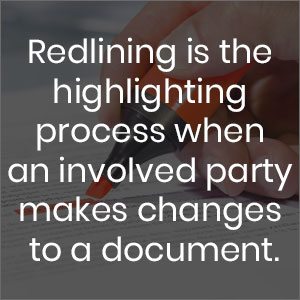Are you an administrative or legal professional, or contract manager? If so, document and contract redlining should be as familiar as taking that first sip of coffee or tea in the morning.
Or have you done it but simply don’t understand why your boss or customers insist on it during the contract versioning and negotiation process? If that’s you, it’s important to know the benefits that redlining offers everyone who interacts with a document or contract throughout its lifecycle.
Let’s explore.
WHAT IS DOCUMENT AND CONTRACT REDLINING?
If you’re a regular user of a word processing application like Microsoft Word, you’ll recognize document redlining. It is the highlighting process that occurs when one of the parties involved in document or contract reviews makes changes to a document. First, the document author turns on the “Track Changes” function in the “Review” tab. Then, every modification going forward is highlighted. Take a look at the example below:
Example of redlining:
In older versions of Word, red was the only markup color that indicated changes made by document or contract reviewers. Newer Word documents have different markup colors to differentiate between each reviewer. Upon each contract review cycle, an authorized individual can either accept or reject proposed changes based on their business policies and comfort with the proposed revisions.
Reviewers can also add comments in the right-hand contract margin. It can justify the reasoning behind their proposed change or explain why a proposed contract change is unacceptable. Typically, final reviewers will send a “clean copy” of a contract – or a version with all acceptable changes approved). This is along with a marked text version that highlights proposed changes.
Redlining is the highlighting process when an involved party makes changes to a document. A heavily redlined paragraph can be difficult to read. Fortunately, some document and contract authoring tools offer the flexibility of showing just simple markup (a red vertical line to the left of a paragraph). Or a full markup text.
REDLINED CONTRACT FILES MUST BE RETAINED FOR THE LIFE OF THE CONTRACT
It is absolutely vital to preserving all versions of contract files with redlined text during the life of the contract. Even beyond. If contract terms are called into question whatever was modified before a contract was signed and executed, a tracked change can be key in demonstrating when a contract change was accepted during the negotiation.
Businesses often have file names and metadata standards for document versions. Let’s say David Authorman created an original contract, Sally Editstein was on the corporate legal team for the other party to the contract, and Joan Approverson was the top signing authority at David’s company. The contract version file names might look like this:
- 3 Year Subscription_SaaS CRM_Proposed Terms_DA_V1
- 3 Year Subscription_SaaS CRM_Free Training_SE_V2
- 3 Year Subcription_SaaS CRM_Customer Success Manager_DA_V3
- 3 Year Subscription_SaaS CRM_Lets Do This_SE_V4
- 3 Year Subscription_SaaS CRM_Engage_JA_FINAL_Markup
- 3 Year Subscription_SaaS CRM_JA_FINAL_Signed_Clean
The root of the file name will likely stay the same throughout the process. However, if you are storing a file in a contract repository, it will likely have its own version control and audit trail functionality. Adding reviewer initials in file names makes it clear if one needs to address why a certain clause has changed.
However, providing the initials of the person – or people – who made changes to a contract in the filename can help the other party to a contract track the collaborator who made changes. Then, that person should be the go-to person for any questions for that version. Contract redlining software functionality is ideal during the negotiation process.
Contract version metadata will also accumulate during the process. Therefore, it is best to strip a contract of any residual metadata between versions and the final, fully-executed contract.
CONTRACT REDLINING VERSUS DOCUMENT COMPARISON
An AI-augmented contract automation review engine can accelerate the process of identifying any potentially problematic contract terms. Assuming a term will work out “eventually” is folly. It’s far better to highlight it before sending it back.
Contract redlining software functionality is ideal during the negotiation process. Yet using a document comparison tool like Workshare can provide an extra level of confidence that legal terms weren’t changed along the way without being called out. Also, it can parse through multiple versions of a contract file and flag missed changes. These could cause undue risk, cost, and pain later on.
So are you looking for ways to streamline your contract review and redlining process while safeguarding your new and ongoing customer relationships? ContractPodAi would be happy to show you the document and contract redlining functionality in a pressure-free discussion. Request a demo and initiate the scheduling process.




